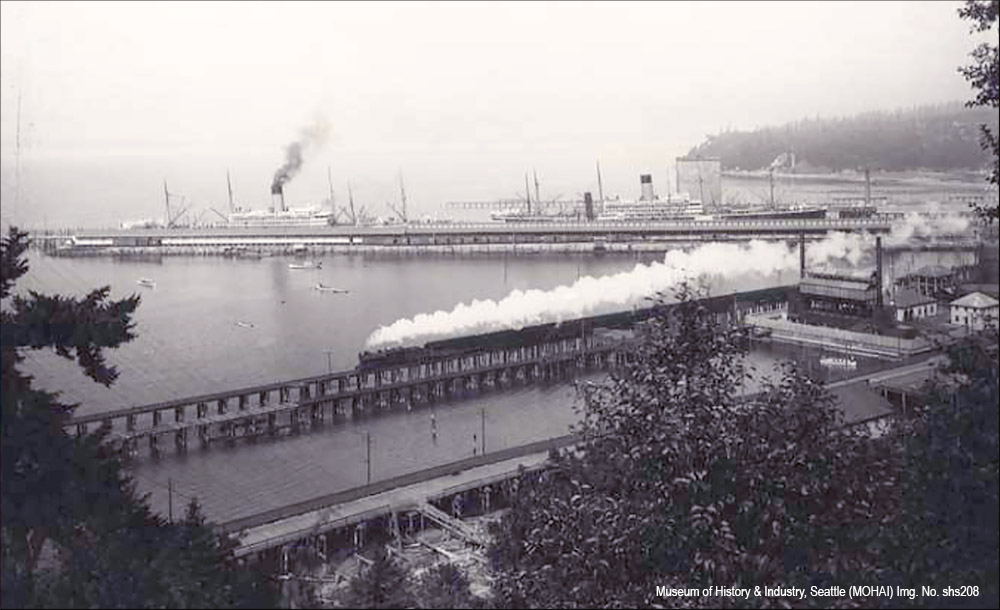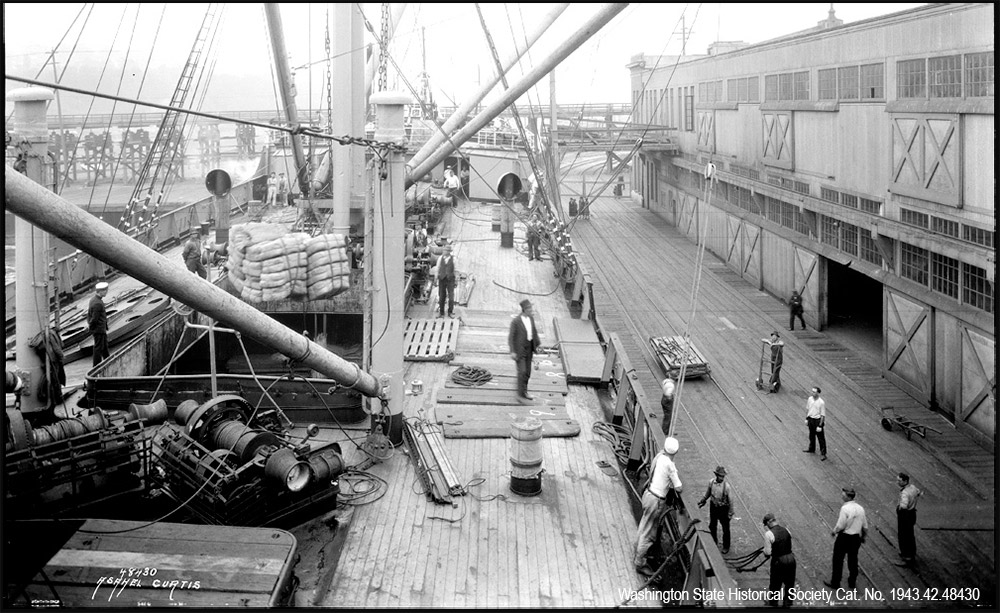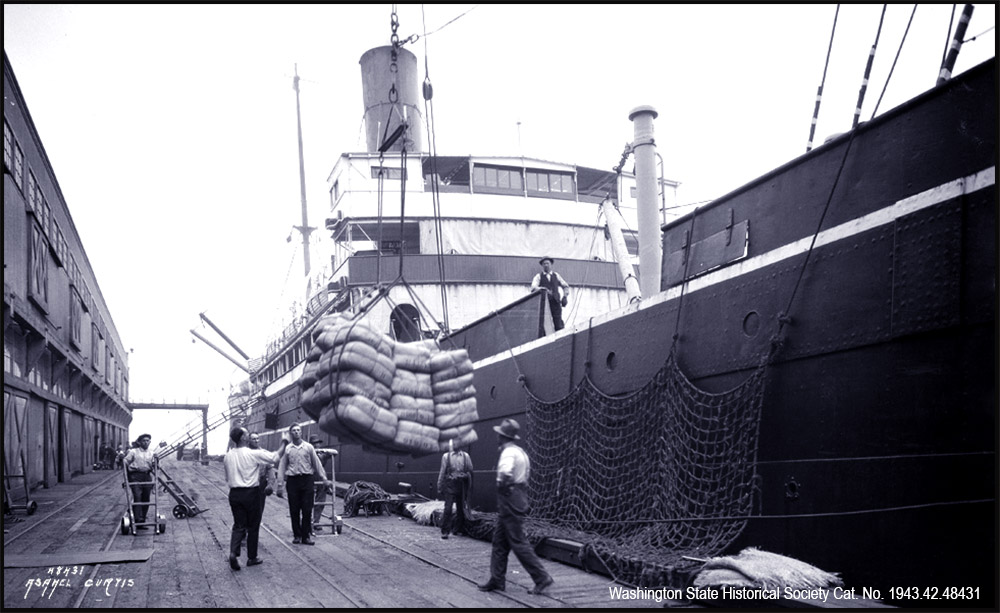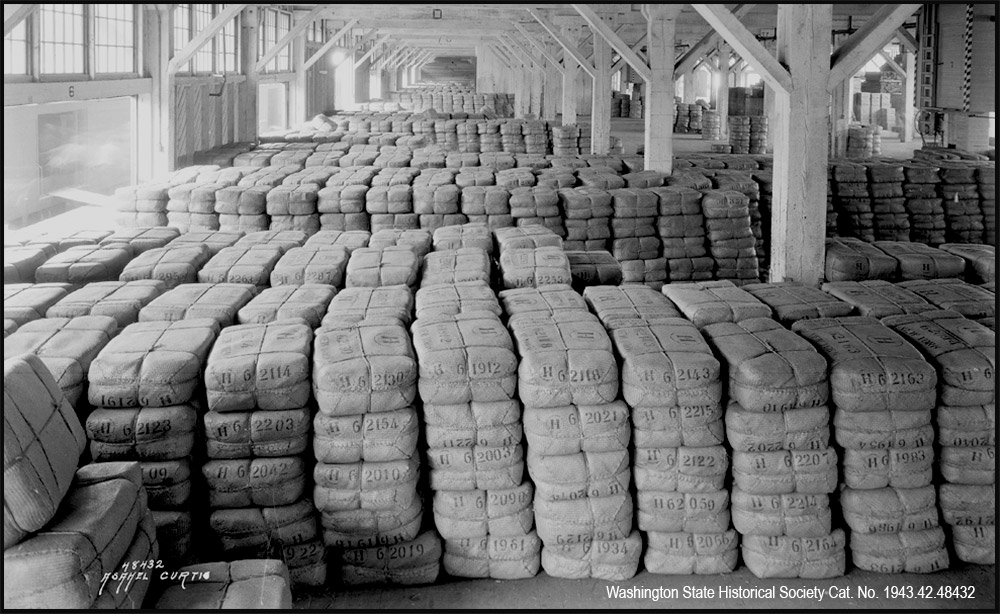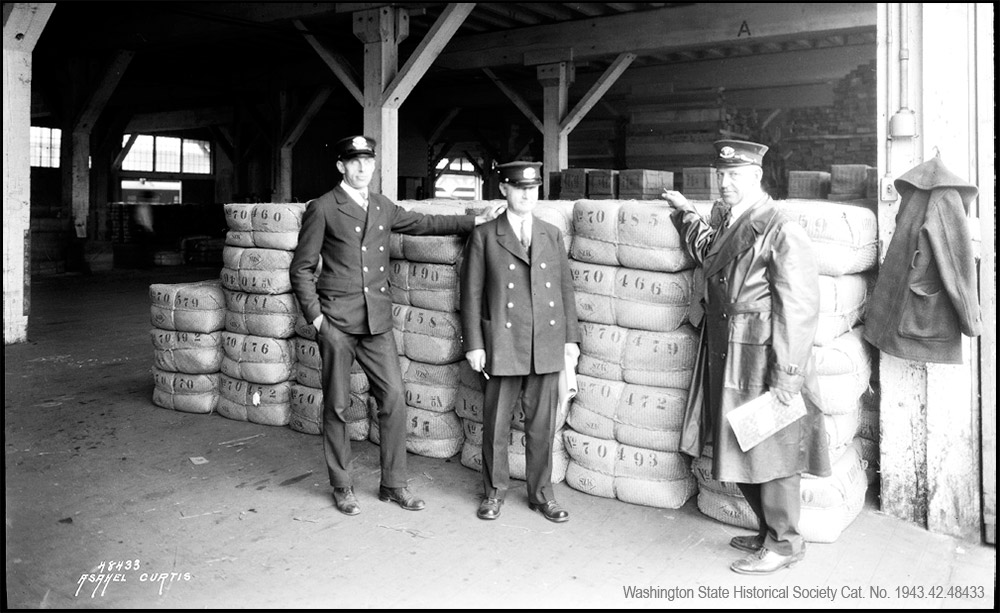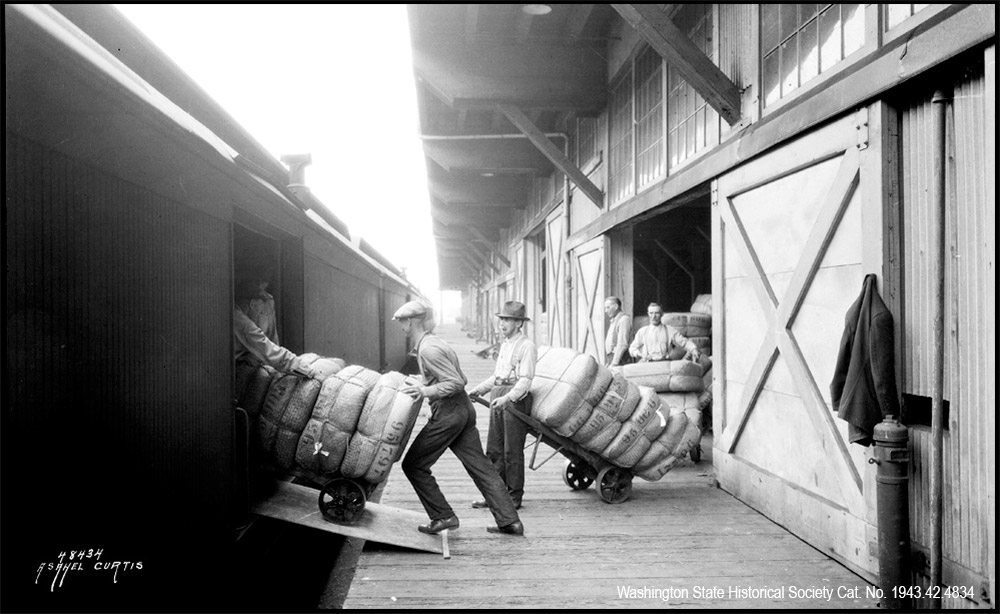Loading the Train
The series of images of unloading silk shown in the slideshow above records longshoremen at the Great Northern Pier 88 in Seattle unloading the Kaga Maru on September 25, 1925 taken by Asahel Curtis.. This illustrates the process of involved in loading the silk trains prior to their departure to the east coast. The Kaga Maru is one of the ships of the Nippon Yusen Kisha's (NYK), Japanese James J. Hill linked his Great Northern Railway Company with the Great Northern Steamship Company, thus providing direct passenger and freight service between the midwestern United States and Asia. The two parts of the system met at the Smith Cove Terminal in Seattle.
This photo, taken around 1906 of Seattle's Smith Cove Pier 88, shows the Great Northern Railway's Oriental Limited racing south along its trestle. In the background are two Great Northern Steamship Company ocean liners, the SS Minnesota, and SS Dakota.
I feel it is important to show the method of material handling used at the time to get a full appreciation for the speed of the trans-loading of the silk cargo from ship to train. The silk in most cases was unloaded before the passengers disembarked.
The Record Run
The Perfect opportunity arrived on August 13th when a large shipment of raw silk arrived in Seattle. 400,000 pounds carried on the NYK's Iyo Maru filling 10 baggage cars plus an additional 326,000 pounds from the AOL's President McKinley filling 9 baggage cars. Special port crews moved the silk to the dock, warehouse, and waiting train in three hours. Working at top speed experienced stevedores loaded each car in eight minutes.
Only the most experienced crews members were selected for the trains, and the engineers were allowed to choose their favorite locomotives from those known to be most reliable and capable of maintaining high speeds without requiring frequent water stops.
The Route
Fresh crews and engines were changed at each division division point, because it was faster to change the locomotive along with the crew rather than service a single engine with coal and water. At division points, security men unloaded to guard the train as conductors and inspectors checked the door seals on the baggage cars. Crews inspected air hoses and steam lines, checked brakes, lubricated journals, and switched locomotives in four minutes or less.
Railroad Gazetteer Map, 1922; Elevation profiles and labeling Copyright 2019, W.D. Madden, The Power School
Train One, Seattle to St. Paul
Cascade Division
The first train left the Interbay Yard in Seattle after loading at Pier 88, the Great Northern Pier at 1:05 pm on August 13th led by P-2 Mountain engine 2512 to cover the Cascade Division. At Skykomish the helper engine F-S-5, 1101 was coupled to help the train climb the grade from Skykomish to Tye, 2198 ft. elevation in approximately 19 miles. At Tye the helper was dropped off and the electric locomotives at Tye pulled the throttled down 2512 through the old Cascade Tunnel to Cascade Station, because the gas buildup from the steam engines could suffocate the crews. From Cascade Station, after leaving the electrics behind, 2512 arrived in Wenatchee at 6:05 pm covering the 161.22 miles of the Cascade Division in 5 hours.
Spokane Division
Here the crew took 10 minutes to couple P-2, 2506 and check the brakes and set out to Hillyard Yard in Spokane at 6:15pm. H-4 Pacific, 1442 took over the next leg down to Troy, Montana, arriving at 1:00 am. The Spokane Division crews completed their 313.54 miles in 6 hrs. 55 min.
Kalispell Division
In Troy the Kalispell Division coupled up another Pacific, H-4, 1459 and made a full train inspection, leaving Troy at 2:10 am the 14th to proceed to Whitefish, Montana. The train picked up a helper engine, E-10, 1000, to assist them in the pull from Rexford to Stryker, a climb of nearly 1000 ft. over 28 miles. After dropping off the helper engine, 1459 pulled into Whitefish, Montana. In Whitefish the the P-2 Mountain, 2505 took over and left for Havre, Montana. At Essex the train picked up helper 1713 an H-6 to help push it up to Summit. This leg is around 18 miles with a gain in elevation of 1338 ft. After leaving the helper In Summit, 2505 slid in to Cut Bank Montana at 8:33 am. The train cleared the Kalispell Division, 262.43 miles in 6 hrs. 33 min.
Montana Division
The train got handed of at the Montana Division point to H-5, 1491. After taking 3 minutes to change engines and check the brakes, the train was off again at 8:36 am to Havre, Montana to hand off the load at Havre to K-1s, 1706, who carried the freight to Wolf Point where the H-6, 1713 went to the end point of the Montana Division at Cut Bank, Montana arriving at 4:47pm traveling 438.50 miles in 8 hrs. 14 mins.
Minot Division
In Williston the Minot Division crew made the engine change to P-2, 2521 in 7 minutes, leaving Williston at 4:54pm and arriving at Minot, North Dakota at 7:27pm covering the 120.32 miles of the Minot Division in 2 hrs. 45 min.
Breckenridge Division
Following a train inspection after the H-4, 1449 was attached, the train left Minot at 8:32pm, arriving at Breckenridge, Minnesota, following a crew change at New Rockford, at 1:55am. The 1449 completed the 272.29 miles of the Breckenridge Division in 5 hrs. 26 min.
Willmar Division
At Breckenridge the H-4, 1473 was cut in, taking 9 minutes, leaving on the final leg at 2:04am the 15th. passing Delano at 5:30am the 1473 covered the 176.11 miles of the Willmar Division in 3 hrs. 26 min. on its way to St. Paul.
Twin Cities Terminal
The 1473 arrived in St. Paul, Minnesota at 6:33am August 15th completed the last 38.32 miles from Delano in 1 hr. 3 min. Ten baggage cars, one coach carrying 200 tons of silk, total time on the Great Northern was 39 hrs. 28 min. averaging 45.2 miles per hour.
Train Two, Seattle to St. Paul
Cascade Division
The second train left the Interbay Yard in Seattle after loading at Pier 88, the Great Northern Pier at 1:00am on August 14th led by E-14, 1013 to cover the Cascade Division. At Skykomish the helper engine O-5, 3310 was coupled to help the train climb the grade from Skykomish to Tye, 2198 ft. elevation in approximately 19 miles. At Tye the helper was dropped off and the electric locomotives at Tye pulled the throttled down 3310 through the old Cascade Tunnel to Cascade Station, because the gas buildup from the steam engines could suffocate the crews. From Cascade Station, after leaving the electrics behind, 3310 arrived in Wenatchee at 6:10am covering the 161.22 miles of the Cascade Division in 5 hours 10 min..
Spokane Division
Here the crew took 10 minutes to couple P-2, 2509 and check the brakes and set out to Hillyard Yard in Spokane at 6:22am. H-4 Pacific, 1451 took over the next leg down to Troy, Montana, arriving at 12:50pam. The Spokane Division crews completed their 313.54 miles in 6 hrs. 40 min.
Kalispell Division
In Troy the Kalispell Division coupled up another Pacific, H-4, 1459 and made a full train inspection, leaving Troy at 1:54pm the 14th to proceed to Whitefish, Montana. The train picked up a helper engine, E-10, 1000, to assist them in the pull from Rexford to Stryker, a climb of nearly 1000 ft. over 28 miles. After dropping off the helper engine, 1459 pulled into Whitefish, Montana. In Whitefish the the P-2 Mountain, 2505 took over and left for Havre, Montana. At Essex the train picked up helper 1713 an H-6 to help push it up to Summit. This leg is around 18 miles with a gain in elevation of 1338 ft. After leaving the helper In Summit, 2505 arrived at Cut Bank Montana at 8:02pm. The train cleared the Kalispell Division, 262.43 miles in 6 hrs. 9 min for an average speed of 42.67 mph.
Montana Division
The train got handed of at the Montana Division point to H-4, 1452. After taking 3 minutes to change engines and check the brakes, the train was off again at 8:02pm to Havre, Montana to hand off the load at Havre to K-1s, 1707, who carried the freight to Wolf Point where the H-4, 1446 went to the end point of the Montana Division at Cut Bank, Montana arriving at 4:14am traveling 438.50 miles in 8 hrs. 15 mins for an average speed of 53.15 mph.
Minot Division
In Williston the Minot Division crew made the engine change to P-2, 2519 in 5 minutes, leaving Williston at 4:54pm and arriving at Minot, North Dakota at 6:58am covering the 120.32 miles of the Minot Division in 2 hrs. 49 min for an average speed of 42.71 mph.
Breckenridge Division
Following a 1 hr. 5 min. train inspection after the H-4, 1448 was attached, the train left Minot at 8:03am, arriving at Breckenridge, Minnesota, following a crew change at New Rockford, at 1:23pm the 15th. The 1448 completed the 272.29 miles of the Breckenridge Division in 5 hrs. 26 min for an average speed of 50.27 mph.
Willmar Division
At Breckenridge the H-4, 1447 was cut in, taking 5 minutes, departing for the final leg at 1:28pm the 15th. passing Delano at 4:47pm the 1447 covered the 176.11 miles of the Willmar Division in 3 hrs. 19 min. on its way to St. Paul for an average speed of 53.09 mph .
Twin Cities Terminal
The 1473 arrived in St. Paul, Minnesota at 5:50pm August 15th completed the last 38.32 miles from Delano in 1 hr. 3 min averaging 36.49 miles per hour.. Nine baggage cars, one coach carrying 163 tons of silk total time on the Great Northern was 38 hrs. 50 min.

